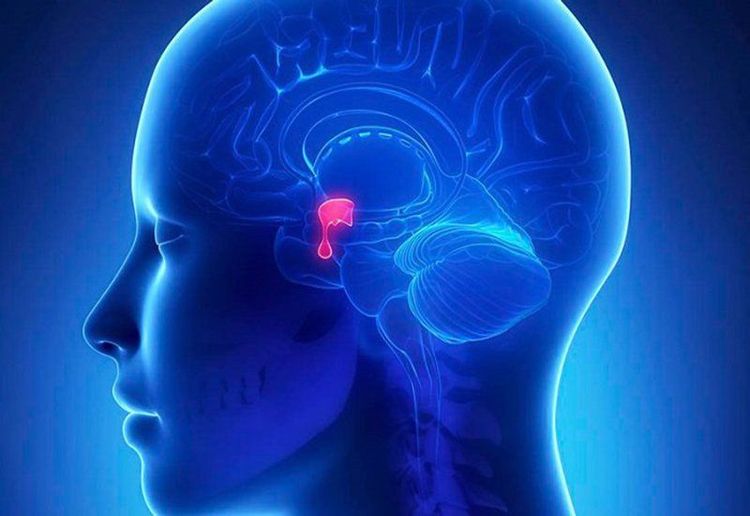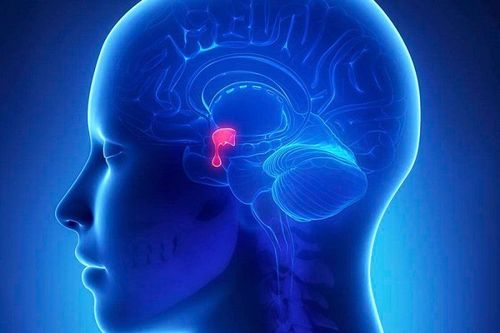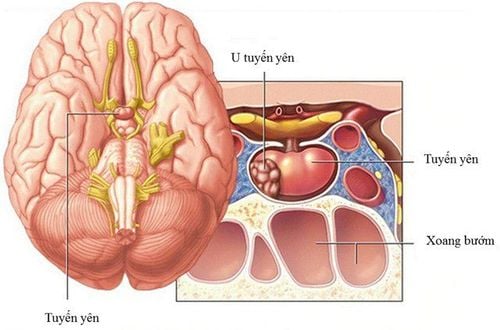This is an automatically translated article.
The main treatment for pituitary adenoma is surgery. Because this is a very small endocrine organ and is located deep in the brain parenchyma, interventions on this area always carry certain risks.
1. What is a pituitary tumor?
A pituitary tumor is an abnormal growth of a tumor that develops in the pituitary gland. Some types of pituitary tumors lead to increased secretion of hormones that control important body functions. Conversely, some pituitary tumors can cause the pituitary gland to produce less hormone.
Most of the time, a pituitary tumor is a noncancerous growth or a benign tumor in nature. These tumors are usually confined to the pituitary gland or surrounding tissues without spreading to other parts of the body.
Regarding treatment, there are different options for treating pituitary tumors, including surgery of the pituitary gland to remove the tumor, administering drugs to control tumor growth, and regulating hormone secretion by the pituitary gland with drugs. . Some pituitary adenomas are discovered incidentally, the disease causes no symptoms, and the plan at this time may be considered to be observation rather than aggressive intervention.
2. Types of pituitary tumor surgery
Pituitary tumor surgery has many different procedures. The indications and effectiveness of each method depend on the type of tumor, its exact location, size, and its effects on nearby structures. Accordingly, there are the following types of pituitary tumor surgery:
2.1. Endoscopic pituitary surgery through the sphenoid sinus
This is the most common way to remove a pituitary tumor. Instruments are inserted through the sphenoid sinus, a space in the skull behind the posterior nasal passages and located just below the brain. The posterior wall of the sinuses covers the pituitary gland.
To perform this surgery, the neurosurgeon must make a small incision along the nasal septum, the cartilage between the sides of the nose, or below the upper lip, above the teeth. Targeting the pituitary gland, the surgeon opens the walls of the sphenoid sinus with a small hand chisel, drill, or other tools depending on the thickness of the bone and sinuses. The entire operation of these tools is observed and controlled through screens located outside the body.
Another approach to the pituitary gland is to use an endoscope. This is a thin fiber optic tube with a small camera placed at the top of the tube. In this way, an incision below the upper lip or along the nasal septum is not necessary due to the advantage of the endoscope allowing the surgeon to see through the small incision made in the back of the nasal septum. From there, instruments will be inserted through the nose and open the sphenoid sinus to reach the pituitary gland and remove the tumor. However, the effectiveness of this technique will depend on the location of the tumor and the shape of the sphenoid sinus.
In general, the endoscopic approach has many advantages. Most strikingly, no part of the brain was touched during the surgery. Therefore, the possibility of brain damage is very low or even non-existent. Besides, this method has less side effects and also does not cause obvious scars. However, laparoscopic surgery may take longer and it will be difficult to remove large tumours.
2.2. Surgery for pituitary adenoma through craniotomy
For larger or more complex pituitary tumors, the patient can only intervene with craniotomy. In this method, the surgeon will work through a hole in the front of the skull, off to the side. Skilled surgeons must work carefully beneath and between the lobes of the brain to reach the tumor.
Craniofacial surgery has a higher risk of brain injury and other complications than laparoscopic surgery for small lesions. However, this approach is actually safer for large and complex tumors. This is because the surgeon can better see and access the tumor and nearby nerves and blood vessels.

Phẫu thuật u tuyến yên qua mở nắp sọ an toàn hơn khi phẫu thuật các khối u lớn
3. Planning for surgical intervention for pituitary tumor
Whether endoscopic pituitary adenoma surgery through the sphenoid sinus or via craniotomy, all cases are planned by the doctor for surgical intervention using instructions through visual simulation with magnetic resonance imaging or computed tomography of the brain.
In other words, in order to achieve optimal surgical efficiency, the surgeon needs to learn as much information about the tumor as possible. It is important to know how large the tumor is and whether it has spread beyond the pituitary gland to plan the best surgical approach and how to remove the entire tumor.
Even, in rare cases, both types of surgery are used at the same time because the goal is to try to completely remove large pituitary tumors that have spread into nearby tissues.
However, as a general rule, the smaller the pituitary tumor, the easier it will be to treat with surgery. As the tumor grows larger and more invasive, the possibility of a cure with surgery alone becomes limited. At the same time, pituitary surgery complications during the intervention and postoperative period also tend to be higher for large and invasive tumors.
4. Possible complications of pituitary tumor surgery
Surgery on the pituitary gland is a highly invasive intervention and requires the surgeon to take great care to try to limit any adverse problems that occur during or after surgery. Pituitary surgery complications during or after surgery such as bleeding, infection, or reactions to anesthesia are rare, but they can still occur.
Most people who have had laparoscopic pituitary surgery will be prone to sinus headaches and congestion in the nasopharynx for up to a week or two after surgery.
If surgery causes damage to major arteries, nearby brain parenchyma, or nerves near the pituitary gland, these interventions can lead to brain damage, stroke, or vision complications. However, the incidence of pituitary surgery complications of this type is quite rare.
When doctors use an endoscopic approach to access the pituitary gland through the sphenoid sinus, a temporary artificial tunnel is created between the sinuses, airways, and brain parenchyma. Therefore, until the wound heals, the patient faces a very high risk of meningitis, encephalitis or central nervous system infection in general. At this time, the manifestation of meningeal injury is the leakage of cerebrospinal fluid from the nose. The risk of this event is dependent on the size and type of pituitary tumor treated.
The phenomenon of diabetes insipidus is also one of the complications of pituitary surgery. However, this complication only occurs immediately after surgery and it is usually localized within a few weeks and then improves.
Complications that damage the remaining parenchyma of the pituitary gland after tumor removal can lead to other symptoms due to a lack of pituitary hormone. This is rare after surgery for small tumors but it can be unavoidable when treating larger pituitary tumors. At this time, if the pituitary hormone levels drop low after surgery, the patient can be treated with drugs that are artificially synthesized pituitary hormones to replace some endogenous hormones.

Một trong những biến chứng nguy hiểm khi phẫu thuật u tuyến yên là đột quỵ, hôn mê
Thus, the patient will always be closely monitored and blood tests will also be checked regularly as the body is able to regulate the pituitary hormone levels to normal. If diabetes insipidus does not improve substantially to baseline, the patient may need to be treated with a nasal spray with desmopressin. In addition, if vitamin or mineral levels change, the patient may need a temporary synthetic supplement for a short time. For example, blood potassium levels are often reduced, so patients may need potassium supplementation via intravenous isotonic solution immediately after surgery.
Thus, complications occur very rarely after pituitary tumor surgery. However, when they do occur, these complications are often severe. The patient should consult with the surgeon about what the patient should monitor in the postoperative period, the need for early follow-up when abnormalities occur for timely intervention, as well as the plan to supplement exogenous pituitary hormones about after.
Customers who have needs of examination and treatment can directly go to Vinmec Health System nationwide or contact for an appointment HERE.
MORE:
Are pituitary tumors dangerous? Symptoms of Pituitary Tumors Pituitary Tumor Surgery
Close-up of prostate cancer treatment with robotic laparoscopic surgery
In April & May 2021, when there is a need for examination and treatment of pituitary tumor at Vinmec Central Park International General Hospital, customers will enjoy double incentives:
- Free specialist examination
- 50% discount for customers with post-examination treatment indications. The program is limited to the corresponding technique of each hospital and to customers who perform this treatment technique for the first time at Vinmec.
Please dial HOTLINE for more information or register for an appointment HERE. Download MyVinmec app to make appointments faster and to manage your bookings easily.













